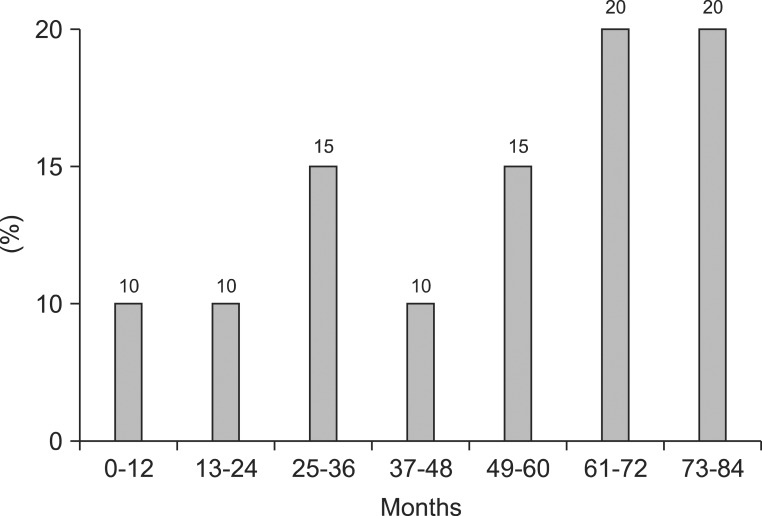Ann Rehabil Med.
2012 Jun;36(3):334-339. 10.5535/arm.2012.36.3.334.
Clinical Characteristics of Children with Rett Syndrome
- Affiliations
-
- 1Department of Physical Medicine and Rehabilitation, National Health Insurance Corporation Ilsan Hostpital, Goyang 410-719, Korea. snoopyhara@hanmail.net
- 2Department of Pediatrics, National Health Insurance Corporation Ilsan Hostpital, Goyang 410-719, Korea.
- KMID: 2266738
- DOI: http://doi.org/10.5535/arm.2012.36.3.334
Abstract
OBJECTIVE
To identify the clinical characteristics and investigate function related aspects of Korean children with Rett syndrome. METHOD: A total of 26 patients diagnosed as Rett syndrome were clinically observed until the age of five or over. We surveyed past history, developmental history, and presence of typical clinical features of Rett syndrome. Furthermore, we investigated differences in clinical characteristics according to functional status and changes in clinical features related to growth.
RESULTS
There were no problems related to gestational, perinatal or neonatal history. Only 12 patients had an ultimate head circumference of less than 3 percentile. Developmental regression was definite in all patients. At final assessment, only 14 patients were able to walk. Twenty patients had an epileptic history requiring medication. Sixteen patients with scoliosis showed progression during serial follow-up. The percentage of patients who were able to walk before 16 months was higher in the high function group than the low function group. The age of regression was 5.4 and 4.0 years in the high and low function group respectively, but the difference was not statistically significant. Scoliosis was more severe and seizure onset age was younger in the low function group.
CONCLUSION
We investigated 26 clinical characteristics in Korean children with Rett syndrome. Their clinical features change according to age, and we believe such knowledge could be utilized in rehabilitation to minimize their disabilities.
Keyword
Figure
Reference
-
1. Matijevic T, Knezevic J, Slavica M, Pavelic J. Rett syndrome: from the gene to the disease. Eur Neurol. 2009; 61:3–10. PMID: 18948693.
Article2. Amir RE, Van den Veyer IB, Wan M, Tran CQ, Francke U, Zoghbi HY. Rett syndrome is caused by mutation in X-linked MECP2, encoding methyl-CpG-binding protein 2. Nat Genet. 1999; 23:185–188. PMID: 10508514.3. Williamson SL, Christodoulou J. Rett syndrome: new clinical and molecular insights. Eur J Hum Genet. 2006; 14:896–903. PMID: 16865103.
Article4. Nissenkorn A, Gak E, Vecsler M, Reznik H, Menascu S, Ben Zeev B. Epilepsy in Rett syndrome-the experience of a National Rett Center. Epilepsia. 2010; 51:1252–1258. PMID: 20491871.
Article5. Hagberg B, Hanefeld F, Percy A, Skjeldal O. An update on clinically applicable diagnostic criteria in Rett syndrome. Eur J Paediatr Neurol. 2002; 6:293–297. PMID: 12378695.
Article6. Percy AK, Neul JL, Glaze DG, Notil KJ, Skinner SA, Khwaja O, Lee HS, Lane JB, Barrish JO, Annese F, et al. Rett syndrome diagnostic criteria: lessons from the natural history study. Ann Neurol. 2010; 68:951–955. PMID: 21104896.
Article7. The Rett syndrome diagnostic criteria work group. Diagnostic criteria for Rett syndrome. Ann Neurol. 1988; 23:425–428. PMID: 2454607.8. Hagberg BA, Skjeldal OH. Rett variants: a suggested model for inclusion criteria. Pediatr Neurol. 1994; 11:5–11. PMID: 7986294.
Article9. Hagberg B, Aicardi J, Dias K, Ramos O. A progressive syndrome of autism, dementia, ataxia and loss of purposeful hand use in girls: Rett's syndrome: report of 35 cases. Ann Neurol. 1983; 14:471–479. PMID: 6638958.
Article10. Hagberg G, Stenborn Y, Witt Engerström I. Head growth in Rett syndrome. Acta Paediatr. 2000; 89:198–202. PMID: 10709891.
Article11. Neul JL, Kaufmann WE, Glaze DG, Christodoulou J, Clarke AJ, Bahi-Buisson N, Leonard H, Bailey MES, Schanen NC, Zappella M, et al. Rett syndrome: revised diagnostic criteria and nomenclature. Ann Neurol. 2010; 68:944–950. PMID: 21154482.12. Einspieler C, Kerr AM, Prechtl HF. Is the early development of girls with Rett disorder really normal? Pediatr Res. 2005; 57:696–700. PMID: 15718369.
Article13. Bashina VM, Simashkova NV, Grachev VV, Gorbachevskaya NL. Speech and motor disturbances in Rett syndrome. Neurosci Behav Physiol. 2002; 32:323–327. PMID: 12243251.14. Smeets E, Schollen E, Moog U, Mattijs G, Herbergs J, Smeets H, Curfs L, Schrander-Stumpel C, Fryns JP. Rett syndrome in adolescent and adult females: clinical and molecular genetic findings. Am J Med Genet A. 2003; 122A:227–233. PMID: 12966523.
Article15. Downs J, Bebbington A, Kaufmann WE, Leonard H. Longitudinal hand function in Rett syndrome. J Child Neurol. 2011; 26:334–340. PMID: 20921565.
Article16. Witt Engerström I. Age-related occurrence of signs and symptoms in the Rett syndrome. Brain Dev. 1992; 14:S11–S20. PMID: 1378244.17. Segawa M. Pathophysiology of Rett syndrome from the stand point of clinical characteristics. Brain Dev. 2001; 23(Suppl 1):S94–S98. PMID: 11738850.
Article18. Glaze DG, Percy AK, Skinner S, Motil KJ, Neul JL, Barrish JO, Lane JB, Geerts SP, Annese F, Graham J, et al. Epilepsy and the natural history of Rett syndrome. Neurology. 2010; 74:909–912. PMID: 20231667.
Article19. Lidstrom J, Stokland E, Hagberg B. Scoliosis in Rett syndrome. Clinical and biological aspects. Spine. 1994; 19:1632–1635. PMID: 7940001.20. Koop SE. Scoliosis and Rett syndrome. Dev Med Child Neurol. 2011; 53:582–583. PMID: 21501155.
Article21. Ager S, Fyfe S, Christodoulou J, Jacoby P, Schmitt L, Leonard H. Predictors of scoliosis in Rett syndrome. J Child Neurol. 2006; 21:809–813. PMID: 16970893.
Article22. Percy AK, Lee HS, Neul JL, Lane JB, Skinner SA, Geerts SP, Annese F, Graham J, Mcnair L, Motil KJ, et al. Profisling scoliosis in Rett syndrome. Pediatr Res. 2010; 67:435–439. PMID: 20032810.


